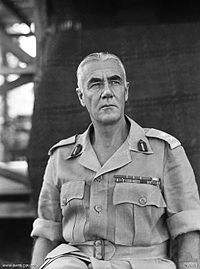Vernon Sturdee Military person
Lieutenant General Sir Vernon Ashton Hobart Sturdee KBE, CB, DSO (16 April 1890 – 25 May 1966) was an Australian Army commander who served two terms as Chief of the General Staff. A regular officer of the Royal Australian Engineers who joined the Militia in 1908, he was one of the original Anzacs during the First World War, participating in the landing at Gallipoli on 25 April 1915. In the campaign that followed, he commanded the 5th Field Company, before going on to lead the 8th Field Company and 4th Pioneer Battalion on the Western Front. In 1918 he was seconded to General Headquarters (GHQ) British Expeditionary Force as a staff officer.Promotion was stagnant between the wars, and Sturdee remained at his wartime rank of lieutenant colonel until 1935. He served in a series of staff posts, and attended the Staff College at Quetta in British India and the Imperial Defence College in Britain. Like other regular officers, he had little faith in the government's "Singapore strategy", and warned that the Army would have to face an effective and well-equipped Japanese opponent.Ranked colonel at the outbreak of the Second World War in 1939, Sturdee was raised to lieutenant general in 1940 and became Chief of the General Staff. He proceeded to conduct a doomed defence of the islands to the north of Australia against the advancing Japanese forces. In 1942, he successfully advised the government to divert the Second Australian Imperial Force troops returning from the Middle East to Australia. He then became head of the Australian Military Mission to Washington, DC, where he represented Australia before the Combined Chiefs of Staff. As commander of the First Army in New Guinea in 1944–45, Sturdee directed the fighting at Aitape, and on New Britain and Bougainville. He was charged with destroying the enemy when opportunity presented itself, but had to do so with limited resources, and without committing his troops to battles that were beyond their strength.When the war ended, Sturdee took the surrender of Japanese forces in the Rabaul area. As one of the Army's most senior officers, he succeeded General Sir Thomas Blamey as Commander in Chief of the Australian Military Forces in December 1945. He became the Chief of the General Staff a second time in 1946, serving in the post until his retirement in 1950. During this term, he had to demobilise the wartime Army while providing and supporting the Australian contingent of the British Commonwealth Occupation Force in Japan. He developed a structure for the post-war Army that included regular combat formations. As a result, the Australian Regular Army was formed, laying the foundations for the service as it exists today.
Search
Military person
| allegiance | Commonwealth of Australia |
|---|---|
| award | |
| military operations | |
| military branch | |
| military command | Eastern Command Chief of the General Staff First Army 8th Division 4th Pioneer Battalion 8th Field Company |
| service number | NX35000 |
| relation | |
| service start | 1908 |
| service end | 1950 |
Topical connections
Vernon Sturdee on Wikipedia
External resources
- http://www.adfjournal.adc.edu.au/UserFiles/issues/41%201983%20Jul_Aug.pdf
- http://www.adfjournal.adc.edu.au/UserFiles/issues/81%201990%20Mar_Apr.pdf
- http://www.awm.gov.au/histories/first_world_war/volume.asp?levelID=67888
- http://www.awm.gov.au/histories/first_world_war/volume.asp?levelID=67891
- http://www.awm.gov.au/histories/first_world_war/volume.asp?levelID=67898
- http://www.awm.gov.au/histories/first_world_war/volume.asp?levelID=67899
- http://www.awm.gov.au/histories/second_world_war/volume.asp?levelID=67906
- http://www.awm.gov.au/histories/second_world_war/volume.asp?levelID=67909
- http://www.defence.gov.au/army/AHU/docs/The_Second_Fifty_Years_Sligo.pdf
